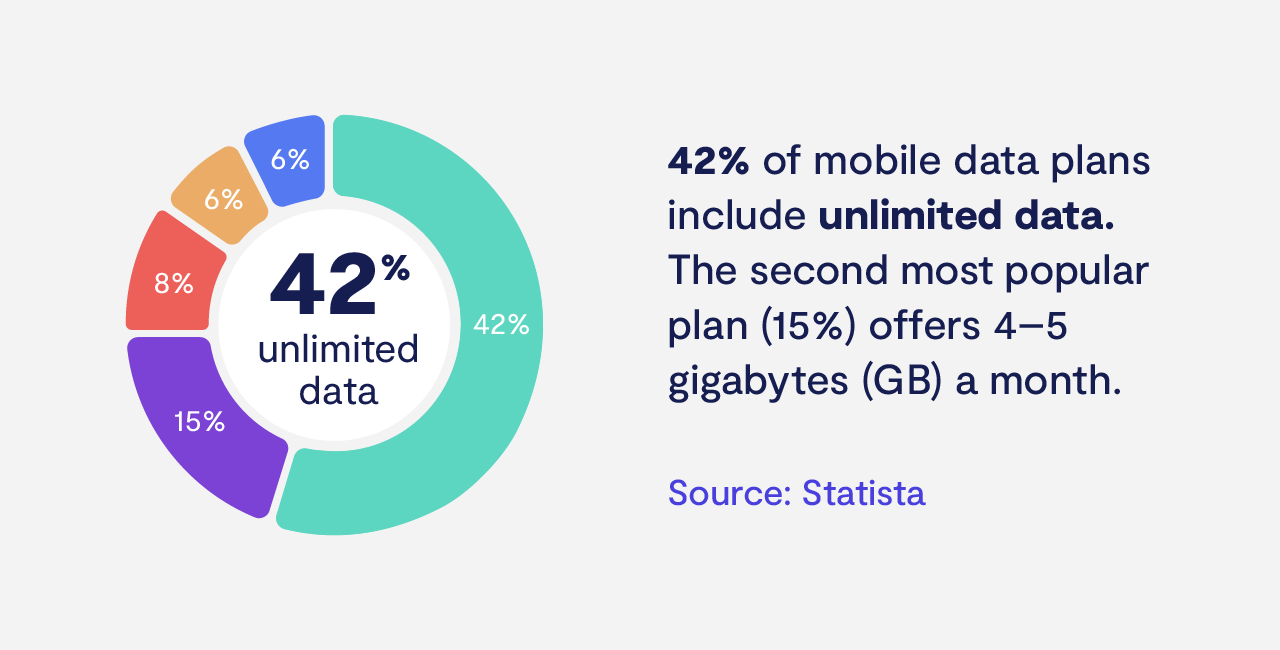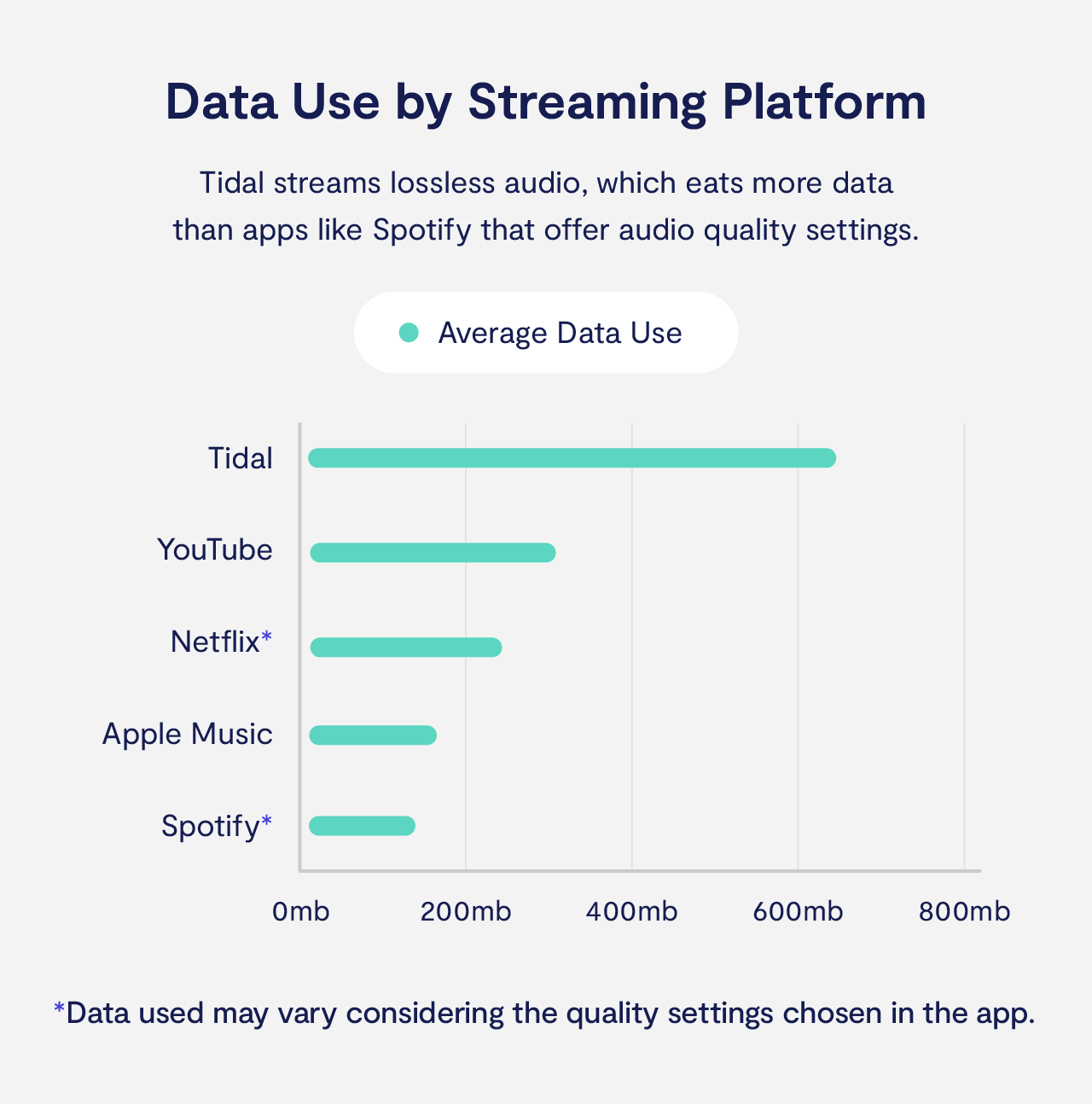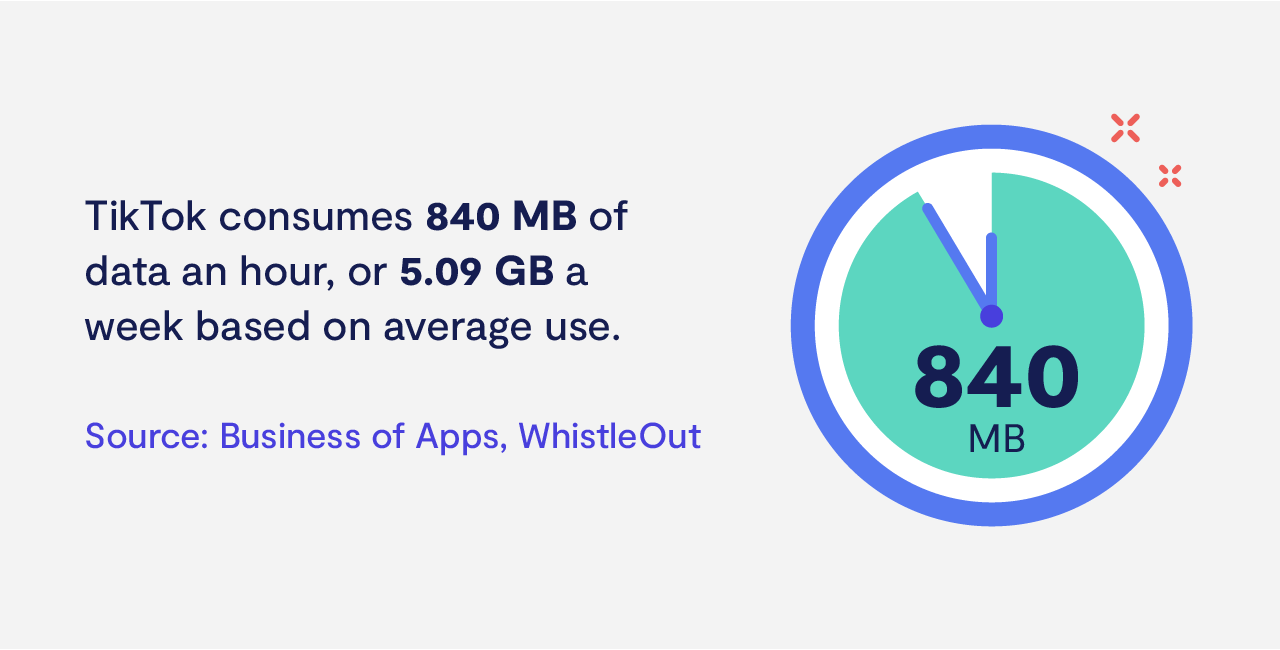How Much Data Do Apps Use? Netflix, Music, and More
Table of contents
- Data Usage When Streaming
- How Much Data Does Netflix Use?
- How Much Data Does YouTube Use?
- How Much Data Does Streaming Music Use?
- Data and App Use
- How Much Data Do Navigation Apps Use?
- How Much Data Does Social Media Use?
- How Much Data Does Browsing Use?
- Streaming and Privacy
- Tips to Conserve Your Battery
Take your phone out and you may find that Facebook is running in the background, you have a new message on Bumble, and notifications from Netflix.
We have the world at our fingertips with amazing and compact tech, but how much data streaming uses each day? It depends on your personal phone use and installed apps.
Whether you’re comparing new phone plans or hoping to improve your battery life, here’s how your devices and apps consume data.
Data Usage When Streaming
Streaming services provide access to your favorite media and live events without overloading your device storage. The downside is that it uses significantly more mobile data than casual browsing online — anywhere from 150–650 megabytes (MB) an hour. To compare, casual browsing uses just 15 MB an hour.

Below, we cover data usage from some of the most popular streaming apps.
How Much Data Does Netflix Use?
Streaming Netflix uses at least 250 MB of data an hour. That adds up fast if you’re binge-watching The Office again or catching up on the latest blockbusters.
Connecting to Wi-Fi is the easiest way to reduce your data consumption — just be sure that you’re using Wi-Fi networks safely.
As an alternative to streaming, Netflix also allows users to:
- Download shows and movies to enjoy offline
- Adjust the video quality
- Turn on “save data” in the app settings
How Much Data Does YouTube Use?
YouTube data consumption is comparable to Netflix’s rate, using approximately 300 MB of data an hour. YouTube TV streaming services use a similar amount of data, but the higher quality the video, the more data it will consume.
The YouTube app offers a few ways for users to save on data:
- Adjust the video quality
- Limit mobile data use in settings (removes HD content on mobile data)
- Turn muted playback off
- Turn autoplay off

How Much Data Does Streaming Music Use?
Music streaming is great for your morning commute, walks through the park, or lounging by the pool. The amount of data you need to get through your favorite playlist varies by app but sits around 144 MB an hour.
Apple Music has a set audio quality that uses around 155 MB an hour. Spotify allows users to set their audio quality, which can decrease their data usage to as low as 43 MB.
Tidal is the exception — this platform offers lossless streaming that preserves audio quality with a high data cost. Tidal uses approximately 640 MB an hour for high-quality listening.
The good news is that most apps allow users to download music to listen to offline.
Data and App Use
Streaming services allow users to take their favorite entertainment on the road, and most users know to watch their data use. But social media, navigation, and messaging apps can also eat at your data plan if you’re not careful.
How Much Data Do Navigation Apps Use?
Navigation apps use an average of 0.93 MB in 20 minutes to stay connected to your current location and track route updates. That’s 2.79 MB for an hour's drive.
Apple Maps eats the most data at 5.49 MB an hour, while Google Maps uses 2.19 MB, and Waze sits at 0.69 MB an hour.
All three navigation apps allow users to download their route before they leave and save on data.
How Much Data Does Social Media Use?
Every social media app prioritizes different features, like photo sharing versus microblogging. Typically, apps that prioritize photos and videos are going to consume more data than text-based apps.
Facebook uses about 80 MB of data an hour with typical use, which is similar to casually browsing the web on your phone. Users who enjoy Facebook video content will use closer to 160 MB.

Visual apps like Instagram and TikTok are among the biggest mobile data hogs available. Browsing Instagram for an hour will use around 720 MB, while TikTok consumes a whopping 840 MB an hour.
Instagram doesn’t offer many data-saving features, but you can reduce video quality on TikTok to save 360 MB an hour.
How Much Data Does Browsing Use?
Your web browser uses around 60 MB of mobile data an hour, though this largely depends on the type of sites you’re visiting. Image-heavy blogs will consume much more data than going down a Wikipedia rabbit hole.
Streaming and Privacy
Most streaming services have a subscription service in which users pay for access to their content. Some offer free services that limit access to content and show advertisements, and many of these services — paid or not — collect or sell user data.
In an analysis of 10 popular streaming services, Common Sense Media identified Apple TV+ as the only streaming service with built-in privacy features that doesn’t sell data or run targeted advertisements.
Netflix received the lowest score with a 46 percent privacy rating and a “poor” data safety rating. While Netflix doesn't sell data, it does serve targeted ads to users and tracks their behavior on the internet and in other apps.
Here’s a look at Common Sense Media’s complete streaming ratings:

Tips to Conserve Your Battery
Phone bills aren’t cheap, and the majority of the cost depends on your data services. The day-to-day priority becomes battery life once you’re locked into your contract. This is the number one influence for most people to buy new high-end phones.
Phone companies advertise all-day charges, but heavy use and aging batteries can significantly impact how long your phone can hold a charge. Here are some tips to bring the power back and leave your charger at home:
- Reduce your screen’s brightness
- Turn on dark mode in your phone settings and supported apps
- Download media and maps while connected to Wi-Fi to avoid streaming
- Turn location and Bluetooth features off when not in use
- Prohibit push notifications in app settings
- Close apps when not in use instead of minimizing them
Similar to data use, image- and video-heavy apps like TikTok and mobile games use more power than text-based apps like Telegram. Many apps also run background applications even when they’re not in use, like your camera and microphone features.
Infographic
Click the link to see the INFOGRAPHIC that highlights some of the apps that have the biggest drain on your battery.
The internet shares everything from rush hour traffic updates to your friend’s opinion on the meme of the week. The benefits of immediate access to news, entertainment, and social connections are incalculable, but the data we use has a price.
If you’ve ever wondered how much data streaming and other apps use, the answer varies. Video streaming consumes 250–300 MB of data while catching up on Facebook takes about 80 MB.
There are always ways to save on data by adjusting app settings and permissions. You can also review and update privacy policies to secure your phone today.


